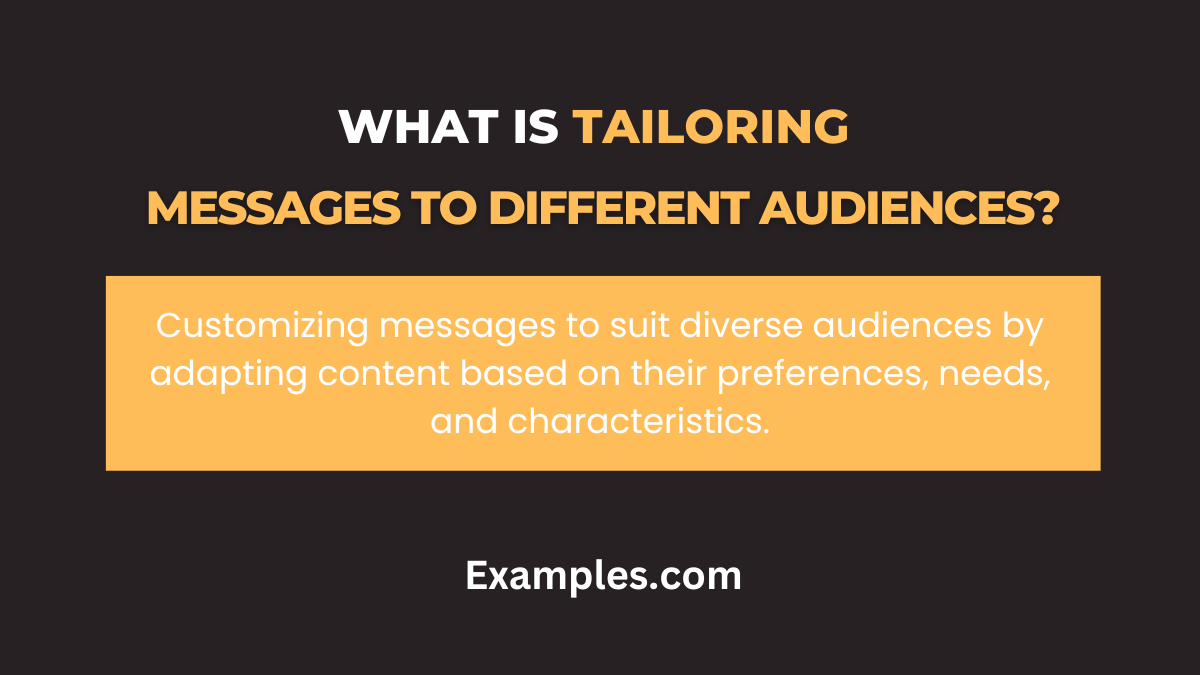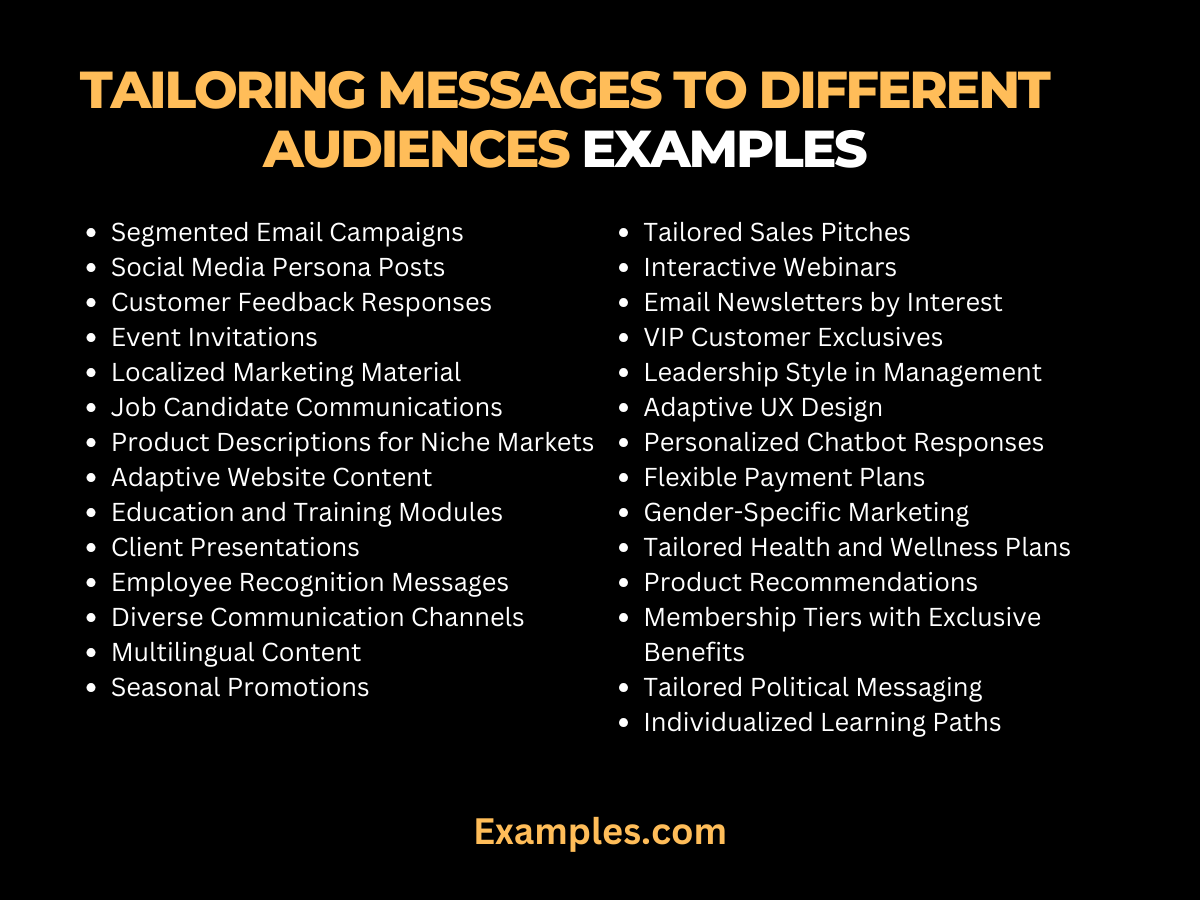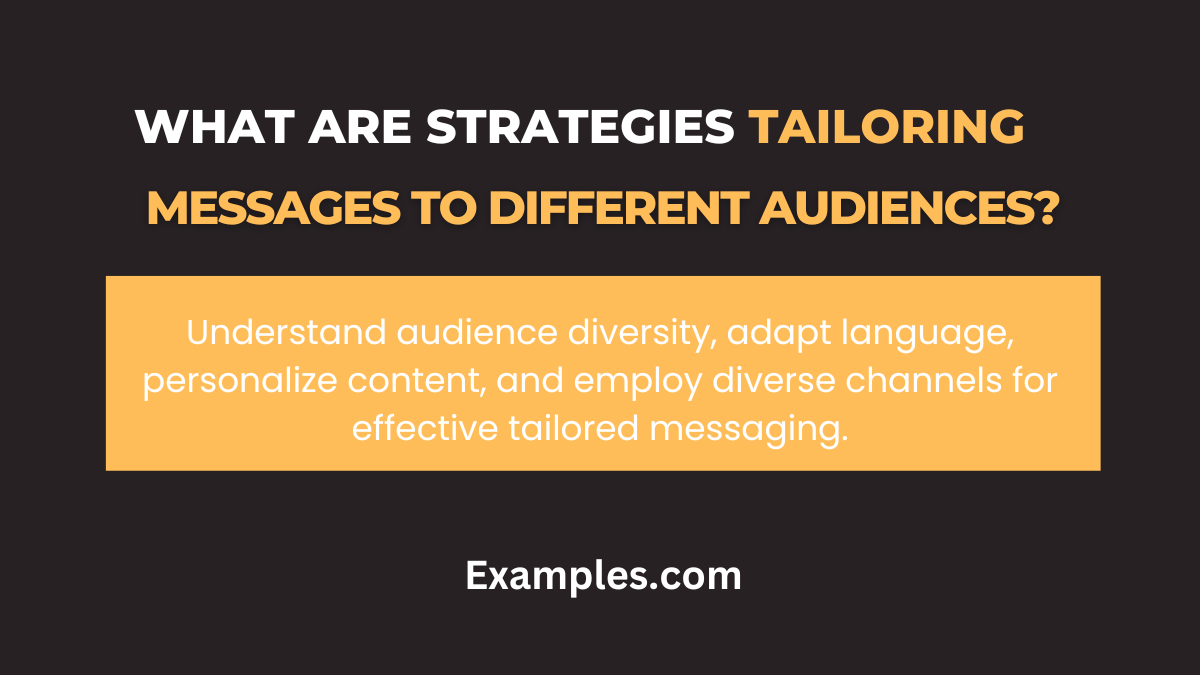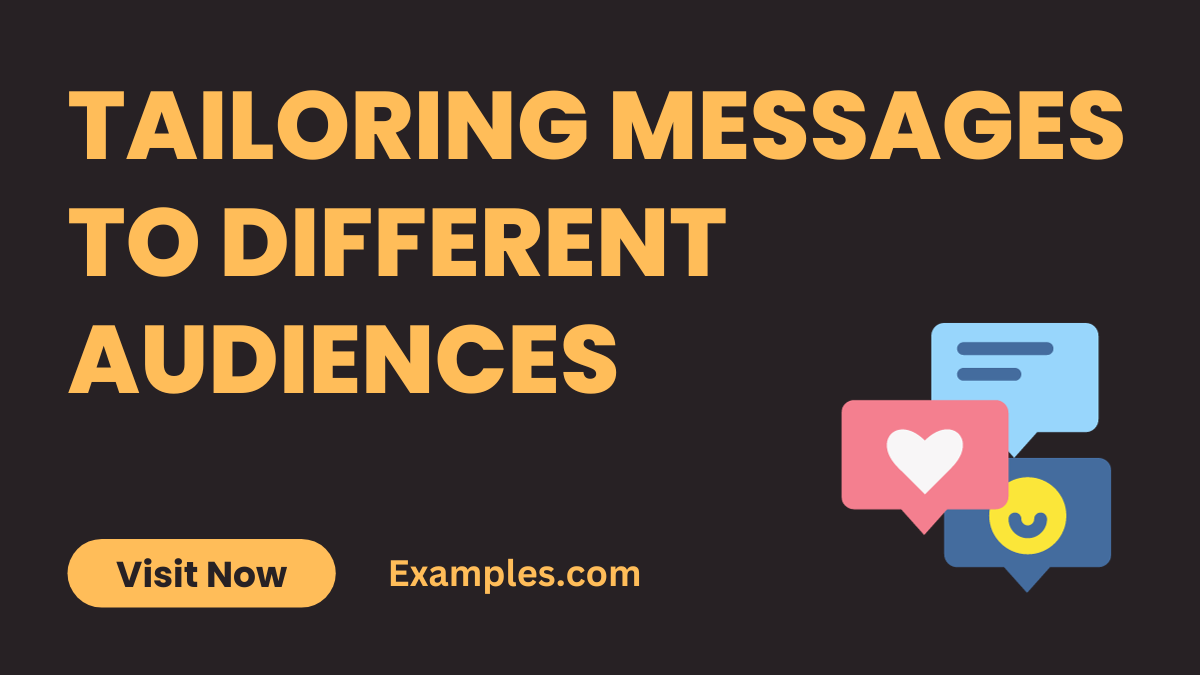29+ Tailoring Messages To Different Audiences Examples
In the realm of effective communication, understanding the art of tailoring messages to different audiences is paramount. This strategic approach involves crafting messages that resonate uniquely with various groups, ensuring maximum impact. By seamlessly incorporating relevant keywords, employing NLP-friendly techniques, and utilizing SEO-rich content, this guide unveils the essence of tailoring messages for diverse audiences, enhancing communication effectiveness.
What is Tailoring Messages To Different Audiences?

Tailoring messages to different audiences is the art of customizing communication to suit the specific needs, preferences, and characteristics of distinct groups. Employing keywords such as “audience segmentation” and “message customization,” this practice optimizes the reception of information, fostering better engagement and understanding. It is about speaking the language of your audience, ensuring a seamless flow of communication that resonates with clarity.
30 Tailoring Messages To Different Audiences Examples

Unlock the power of personalized communication with these 30 tailoring messages to different audiences examples. From marketing to interpersonal relationships, these instances showcase the versatility of adapting messages. This SEO-friendly guide ensures you grasp the art of audience-centric communication, employing NLP techniques seamlessly.
- Segmented Email Campaigns: Craft distinct email content for various customer segments, using tailored language and offers to address specific needs.
- Social Media Persona Posts: Create diverse social media content reflecting different personas within your audience, resonating with varied interests and preferences.
- Customer Feedback Responses: Tailor responses to customer feedback, addressing concerns individually and expressing gratitude for positive experiences.
- Event Invitations: Personalize event invitations based on attendee interests, ensuring a higher RSVP rate through targeted appeal.
- Localized Marketing Material: Adjust marketing materials to suit regional preferences, incorporating cultural nuances for a more relatable message.
- Job Candidate Communications: Tailor communication with job candidates, emphasizing different aspects of the company culture and role based on the candidate’s background.
- Product Descriptions for Niche Markets: Modify product descriptions to highlight features most relevant to specific niche markets, optimizing appeal.
- Adaptive Website Content: Customize website content dynamically based on user behavior, providing a tailored experience for diverse audiences.
- Education and Training Modules: Adjust training modules to cater to different learning styles, ensuring engagement and understanding.
- Client Presentations: Tailor presentations to address the unique goals and challenges of each client, showcasing a personalized approach.
- Employee Recognition Messages: Recognize employees individually, highlighting their unique contributions within the team.
- Diverse Communication Channels: Utilize various communication channels tailored to your audience’s preferences, be it email, social media, or in-person meetings.
- Multilingual Content: Translate and adapt content into multiple languages to reach a global audience effectively.
- Family vs. Professional Social Media Posts: Maintain a distinction between personal and professional social media content, tailoring posts to each audience appropriately.
- Seasonal Promotions: Adjust promotional messages based on seasons, holidays, or cultural events, aligning with the current zeitgeist.
- Tailored Sales Pitches: Customize sales pitches to address specific pain points or aspirations of potential clients.
- Interactive Webinars: Engage audiences through interactive elements in webinars, catering to different learning preferences.
- Email Newsletters by Interest: Send newsletters segmented by the recipient’s interests, providing targeted content for enhanced engagement.
- VIP Customer Exclusives: Offer exclusive deals or content to VIP customers, acknowledging and rewarding their loyalty.
- Leadership Style in Management: Adapt leadership communication styles to resonate with diverse team members, fostering a positive work environment.
- Tailored Newsletters for Employee Updates: Send internal newsletters with tailored content, sharing relevant updates based on departmental interests.
- Adaptive UX Design: Design user interfaces that adapt based on user behavior, enhancing the overall user experience.
- Personalized Chatbot Responses: Program chatbots to provide personalized responses based on user queries and preferences.
- Flexible Payment Plans: Offer varied payment plans tailored to different customer financial situations, ensuring accessibility.
- Gender-Specific Marketing: Customize marketing messages based on gender preferences, acknowledging and respecting diverse perspectives.
- Tailored Health and Wellness Plans: Develop health and wellness plans that consider individual needs, promoting a holistic approach to well-being.
- Product Recommendations: Provide personalized product recommendations based on user behavior and preferences, enhancing the shopping experience.
- Membership Tiers with Exclusive Benefits: Offer different membership tiers with exclusive benefits, catering to varied customer loyalty levels.
- Tailored Political Messaging: Adjust political campaign messages to resonate with diverse voter demographics, addressing specific concerns.
- Individualized Learning Paths: Create personalized learning paths in educational platforms, catering to diverse student strengths and preferences.
Tailoring Messages To Different Audiences Examples in Literature
In literature, tailoring messages caters to diverse readership. From nuanced character perspectives to varying tones, authors adeptly tailor messages. SEO and NLP techniques can enhance storytelling for broader engagement, ensuring literary works resonate across a spectrum of audiences.
- Character Dialogue Variation: Authors adjust dialogues for distinct personalities, creating relatable connections for diverse readers.
- Cultural References: Infusing diverse cultural elements bridges gaps, appealing to readers from different regions.
- Narrative Tone Shifts: Authors employ shifts for varied emotions, ensuring resonance with varying sensitivities.
- Genre Flexibility: Tailoring extends to genre choice, accommodating readers seeking different experiences.
- Interactive Storytelling: Incorporating tech-savvy elements ensures a dynamic experience for modern readers.
- Dialect Representation: Authors use language nuances for authenticity, making narratives relatable to diverse linguistic groups.
- Universal Themes: Crafting resonant themes strikes a chord across different cultures and age groups.
- Diverse Protagonists: Featuring characters from varied backgrounds broadens literary appeal.
- Parallel Storylines: Incorporating multiple narratives caters to readers with diverse interests.
- Adaptive Story Pacing: Tailored pacing ensures engagement with varying reader preferences.
Tailoring Messages To Different Audiences Examples for Students
Adapting educational messages is crucial to engaging students with different learning styles and preferences. SEO-friendly educational content and NLP techniques in instructional design enhance the student learning experience, making education more accessible and impactful.
- Interactive Learning Modules: Engage students with interactive elements for varied learning preferences, ensuring optimal understanding.
- Personalized Study Plans: Tailor plans to individual strengths, offering a customized path for academic success.
- Multimodal Learning Resources: Provide diverse formats like videos and podcasts for comprehensive learning experiences.
- Adaptive Assessment Strategies: Vary assessment methods, using group projects for bold initiatives and quizzes
- Student-Centric Communication: Foster inclusivity by using language and examples that resonate with diverse cultural backgrounds.
- Flexible Classroom Settings: Accommodate diverse needs in physical or virtual classrooms for improved focus.
- Peer Collaboration Opportunities: Encourage social learners through collaboration, fostering a sense of community.
- Individualized Feedback Approaches: Recognize diverse preferences, providing detailed comments or concise summaries.
- Customizable Learning Paths: Promote autonomy with platforms allowing students to customize paths based on interests and career goals.
- Culturally Relevant Curriculum: Make education inclusive with diverse perspectives and cultural references.
What Strategies can we use for Tailoring Messages To Different Audiences?

To tailor messages effectively, understand your audience, segment based on demographics, and adapt language and tone. Diversify communication channels, reaching audiences on preferred platforms. Personalization is key; address specific needs to enhance message relevance and encourage engagement.
Why it is Importance of Tailoring Messages To Different Audiences?
Tailoring messages is crucial for several reasons:
- Enhanced Relevance: Tailoring messages ensures content aligns with the specific needs, preferences, and cultural backgrounds of diverse audiences, making it more relevant.
- Improved Understanding: Customizing messages enhances comprehension by aligning content with the existing knowledge and experiences of each audience.
- Building Trust: Tailored communication fosters trust as audiences feel directly addressed, establishing a connection based on their unique interests and concerns.
Tips for Effective Tailoring Messages To Different Audiences
- Audience Segmentation: Divide your audience based on demographics, interests, and preferences to create targeted messages.
- Adapt Language and Tone: Adjust your communication style to match the formality or informality preferred by each audience.
- Diversify Communication Channels: Use a mix of channels such as email, social media, and in-person interactions to reach your audience effectively.
- Personalization: Tailor your message to address the specific needs and pain points of each audience, enhancing relevance.
- Understand Audience Knowledge Level: Cater your message to align with the existing knowledge of your audience, ensuring better understanding.
- Build Trust: Customized messages build trust by establishing a direct connection and relevance to the audience’s needs.
- Increase Engagement: Tailoring messages leads to higher levels of engagement as content resonates with the specific interests of each group.
In today’s diverse and Dynamic Communication landscape, tailoring your messages to different audiences is not just a skill but a necessity. By understanding the unique needs, preferences, and perspectives of your target audience, you can create powerful connections that resonate on a deeper level. Whether you’re a business looking to engage customers, a nonprofit aiming to convey your mission, or an individual striving to communicate effectively, the ability to adapt your message is a key to success.
In conclusion, mastering the art of tailoring messages allows you to bridge gaps, build trust, and foster stronger relationships. Remember, it’s not just about what you say, but how you say it that truly matters. So, keep honing your Communication Skills, stay attuned to your audience, and watch your messages transform into impactful conversations.



